Sat Sep 30 16:38:39 CEST 2017
GF, forecasted 3-4m/s
Fazer XL and XXL stacked on 35m 180kg lines
Two 23m (75 ft) prism tube tails
To carry stuff
After the soon 3 months on QLKing I decided to end that test/project and return to DLKs (and "at the same time" continue with QLKs). During the QLK time I got kind of "transportation spoiled". I only had two kites to carry around: B-series 1.5 std and full vent. The full vent venting holes are patched with removable thin sheets of cellophane attached with (centimeter wide strips of) tape.* Included in the package was two, three and four wrap spars, so these two kites could handle (well could be used by me to practice at least) all the wind conditions that I met during this period. The two quite small QLK kite sleeves were tied together using the strings already on the sleeves (the strings normally used to close the bags i.e.) and hung comfortably over the shoulder and backpack during transport - it wasn't even necessary with a kite bag. Today however the ski bag was the available option to carry the Fazers, the tails and the QLKs and a few line sets. Suddenly a 5.5 kg (12 lb) ski bag was hanging on the shoulder again.
* The second iteration of cellophane/tape patching would be to make the tape strips towards the LE somewhat wider. The reason for this is that sometimes I need to press it at the start of the session and possibly one more time to make it stick well. Hopefully the wider tape closer to the LE would improve things. The tape used here is intended for large sheets of polyethene/polyethylene used here because the glue has never left any residues for me.
Preparation, making and repair
This the first time I pilot a stack or see any stacks of more lines than one. Some info on how I made it can be found in in http://kitelife.com/forum/gallery/image/6234-stack-work-in-progress/ :

The stack was made earlier during the summer. The kites themselves have also been resting for more than half a year. Part of the reason has been broken stand offs that had snapped/cracked. The reason why only the Fazer stand offs are the only ones that snap for me is due to the often long line lengths making it difficult to see if a line is wrapped around a wing. You also typically pull harder when starting, meaning that if the line happen to be around the wing the stand off is more likely to break.
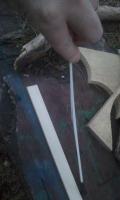
This Fazer XL stand off was damaged during a start resulting in delamination and snapping fibre (bundles).
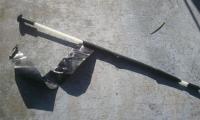
Could tape keep the fibre bundles together and work as a mold during the repair?
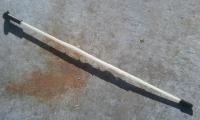
Nope, the tape mold approach didn't work out well. The resulting surface was very rough - best seen in the shadow edge. And, I really dislike sanding down glass fibre - itchy, itchy, itchy!

The Fazer XXL's stand off was instead repaired using heat shrink tubing. Here the heat shrink tube and epoxy repair had to be split into a two step process, because the cracks were long and the tubing could not be slid over the ends of the standoff. Look closely and you can see that the first step is already finished.
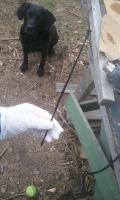
No sanding required when heat shrink tubing was used. The pin was not absolutely straight afterwards. Using some kind of a alignment jig would likely have produced a straighter result. To the right you can see the hot air gun used to shrink the tube.
The dog in the background might look cute, but is really internally about to explode:
"The BALL, the BALL - STUPID!!! Can't you see the BALL stuuupiiid??!!".
She might not be of much use when it comes to get work done in outdoors (making you feel bad for not playing with her constantly), but at least fanatically returns any tennis ball shot if you work on your serves in the garden. When playing with (stealing from) the German shepherd she wins by outmaneuvering, even though the German shepherd runs faster when running in straight line on a field. A very never ending playful dog!
I decided to try to repair the stand off rods themselves instead of making new ones. I believe that there are several benefits in getting better with epoxy and fibre repairs (or other plastic fibre composites?): if spares/spars break at the wrong time and you don't have spares you have a way out, the feeling "I did this" instead of buying, if your kite ever would require no longer available rods, doing composite repairs could offer a way out. I also consider (/an idea could be) to increase the strength in LE of DLKs just to make it more robust when tip stabbing etc. or if I ever would come to the kite surgery of making a frame lighter. Spars are often uniform throught out the length, while the loads are not. You can have an extra high load in LE connectors or just below the LLE/LS-connector e.g. When it comes to keeping the fibres (somewhat) together, squeezing out excess epoxy, speeding up the curing of the epoxi and minimizing the after work, heat shrink tubing rules and tape "sucks" (to my somewhat limited experience). A requirement is that there is enough room so that you can slide the heat shrink tubing on and it shrinks enough. Tape however is good for masking - covering places where you don't want any epoxy.
A common type of heat shrink tubing shrinks to half of its original size (1:2). You can however get hold of (in shops like (Farnell, RS components, ELFA, etc...) sorts that does 1:4 and 1:6 shrinkage at various temperatures.
Out on the field
The wind was a bit on the lower side for the somewhat heavy Fazers. I had to work a bit to keep them in the air. After briefly testing the XXL just to verify that I remembered the DLK (Fazer) control well enough (after the DLK pause) I assembled and connected the XL to the XXL. The result was surprising - it just worked out of the box! I didn't feel that it was necessary to do any tweaking. On the other hand one of the to sources of how to do the stack lines was KL so the bridle should be just fine![]() .
.
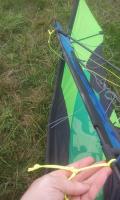
In the stack the XXL nose was tilted backwards about a centimeter relative to the XL. The stack line connectors on the Fazer XL were prepared for further adjustments, but it didn't seem necessary.
The XL had a slight tendency to wobble a bit during most starts, but was quite well behaved otherwise - unless you are "asking for it". Perhaps not so strange oversteer has always been a "hallmark" of the (my?) XL. It is not such a bad thing once I learned to handle it. During windier days I'd say the XL got the temperament of a leaping calf that suddenly can grab you and make you end up three steps downwind. Only one time during this session I was a bit surprised when the stack fell out of the sky after a snap stall.
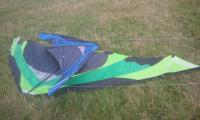
Unless provoked, the kites flew synced, albeit the XL got some oversteer.
The main goal of the day was to get the stack working and if it did, try it with the tails. In the a bit low wind and new circumstances I limited the flying to figure flying (how much more than that can you do with a stack b.t.w.?). Only a few times I had the privilege of being dragged by the stack. The most trick like I accomplished was a cart wheel, which demanded a bit more persuasion than usual to work with the stack of different sized kites. Side slides were also possible. Well another thing, but I don't know if you can call it trick-like, was when running quickly backwards to stabilize the stack in the low wind during a start, which caused me to fall backwards like some fall in a Laurel and Hardy movie:
Even though I somersaulted backwards on the ground over one of the shoulders it didn't hurt. I guess the pull from the kite limited the speed of the fall.
Unfortunately I don't have any photos of the stack in flight. The tails were attached to the bridle of the XXL where the LS meet the LE. Visually it would have given the same effect if the tails were attached to the wingtips of the XL. The perspective I had of the kite almost made it look like one kite except if the XL was oversteering/wobbling. Otherwise the size of the stack, long lines, double tails and slow flight gave it kind of dignified look. The effect of the double tail when doing tight loops was however a bit of a disappointment (slow turns of forward travel looked great though). The inner wing tip and tail hardly moved. Moving the tails inwards to somewhere closer to the stand offs could be one way to make the tight loops look better. Another way to make the loops look better could be to attach one tail to each spine (should at least be interesting to see from the side). Perhaps tight loops with the current position also looks better from the side, but piloting the kite meant that I hadn't that view.
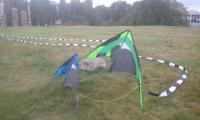

The position of the tails can be adjusted to make the tight loops look better. Forward flight looked good (as seen from the pilots view).
Future
The Fazers are quite robust (heavy). One project I consider (i.e. I like the idea but it is not very likely to be implemented) is to make an extra set lower spreaders to use in lighter winds. The diameter of the current ones are 10 mm for the XL and 12 mm for the XXL. Preferably, if it would be good if it would be possible to get hold of thin walled tubes of the same or larger diameter so that the stiffness of the tubes didn't go down too much. What I really would like to do when I "grow up" as a kiter (if you can ever do that with kites) is learn how to handle my sewing machine well and for some reason get an enormous amount of spare time. Then I'd do a kite based on a truss construction ( https://en.wikipedia.org/wiki/Truss , https://en.wikipedia.org/wiki/Forth_Bridge ) instead of single spars. A starter project could be weight reduced spreaders for the Fazers. The weight of the Fazer XL spreaders, 1 TS +2 LS, (according to a very old scale) are 190g for the Fazer XL (680g for the whole kite incl. the stack bridle connectors, total weight according to the Fazer XL datasheet is 615g) and the spreaders of the Fazer XXL are 410g (1305g or 46oz for the whole kite including stack lines and end caps, literally "~xxx g" in the Fazer XXL datasheet). A truss shaped spreader could have a smaller cross section area, while the larger total diameter prevents them from flexing out sideways during compressive load. The, still dreaming, project after that would be the all truss and all mylar sail kites. On the other hand (still sticking to large kites) acquiring another large kite (like Topas 3.0 or Hot Stripe XL?) could get the diameter of the spars down and hopefully the kite up more easily in low winds. No I haven't done much research here - sometimes you just want a kite.
No I don't think that I'll fly this stack very often. I miss the tricking possibilities to much. My plan is to get somewhat more acquainted with the control and also to see how much wind I can handle. For next years kite festival the stack is a possible contribution, provided I can find a good place with good winds a bit from the centre of the festival and with not to many people around. Although there have been no good multi line kites during at the festival the two last years (which equals to the times I have been there) I like to increase the competitiveness (yes there are a few prices) by always offering something new and most likely put a tail on it. Does this approach have a light scent of crowd-pleasing? During the last festival I handled it in the following way: Before the price ceremony I flew dual DLKs with tails and after the ceremony I did DLK (one kite) tricking to also demonstrate that aspect of kiting as well. If there would be room for the Fazer stack at the next festival I'd say that the odds look good - the bystander interaction today consisted of three chats, while the usual number could be a chat perhaps every third time.
When walking of the field after the 4h stacked session it instead felt like after long day of outdoor (garden/house) work. It was early to bed that night. A slight muscle soreness remained for a few days after as a receipt of that kiting can offer good physical exercise.


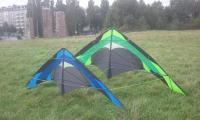
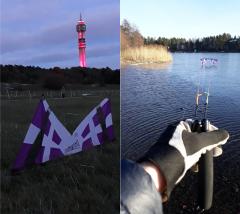
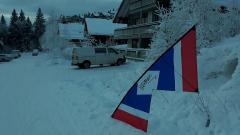
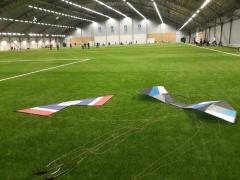

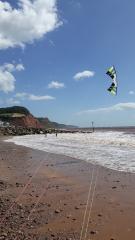


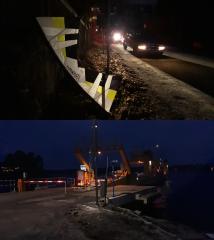
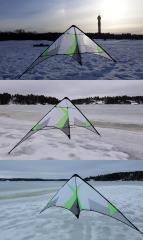
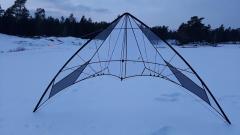
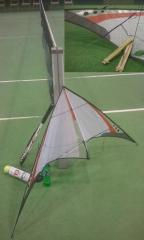

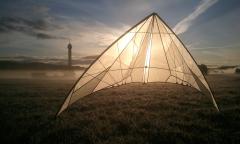
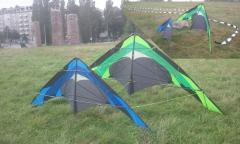
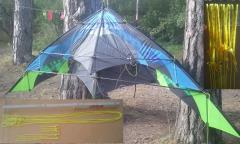

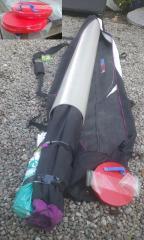
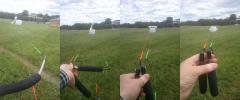
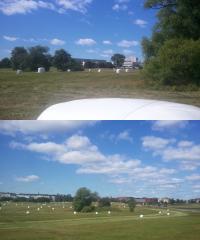


0 Comments
Recommended Comments
There are no comments to display.